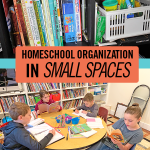A dedicated homeschool room sounds like a dream! Imagine maps on the walls, neat bookshelves, and pencils and markers neatly arranged in coordinating jars. However, don’t be discouraged from homeschooling if your living situation can’t provide a dedicated homeschool room. My family has homeschooled in a variety of small spaces, including in a 1000 sq. ft. apartment with no yard - when there were still seven kids living at home!
Whatever your situation, if you wish you had more room for storage or day-to-day studies, here are 5 tips for homeschool organization in small spaces.

1. Designate Easy-Access Storage
You won’t be able to keep a stash of every supply that every grade of homeschooler could possibly need on hand when you’re homeschooling out of a small space. But you can look ahead in your Instructor’s Guides and prep what's needed. I like to give each child a specific shelf or cupboard that contains the books and tools that they’ll be using on a regular basis.
Having a dedicated storage space for each student minimizes time spent hunting for lost utensils. Bonus: when each item has a home, children know where to return it when they are finished.
A bookshelf with cubbies and a chest of drawers in the main living space might be all you need to keep your homeschool materials organized!

2. Embrace Multi-Purpose Space
While homeschool rooms look gorgeous on Instagram, you don’t actually need desks, a school table, or wooden chests full of manipulatives, games, and puzzles to make homeschool work for you.
- The dining table can serve as a space to work on workbooks.
- The kitchen is perfect for most science experiments.
- Living room couches are a comfy place to enjoy Read-Alouds together.
- Shelves in children’s bedrooms or closets can house educational games and puzzles.
When living areas double as learning areas, rules about staying tidy are even more necessary. You don't want pencils, Readers, and learning paraphernalia strewn all over your small-but-efficient living space! Invest in habit training so children know to quickly return books and pencils to their designated storage locations.

3. Decorate with Learning Tools
Even when homeschooling in tight quarters without a dedicated school room, don't think you can't make use of fun educational decor! I say go for it!
Thankfully, we no longer live in the age when educational decorations were composed of garish primary colors and illustrations that few moms would want marching around their living rooms.
- Wall maps can be stylish decor!
- A framed periodic table might be a fun and quirky print to hang in the kitchen—your designated location for science experiments.
- And if you have younger students, there are even tasteful alphabet and number charts that can double as home decor.
4. Don’t Hoard Curriculum
There’s always a temptation to hold onto a curriculum that didn’t work the way you thought it would. You keep it, thinking one of these excuses:
- You may want to use it with another kid down the road.
- Some parts of it might come in handy someday.
- You spent money on it, and it's a waste to get rid of it.
When you homeschool in a small space, you need to be much more intentional about what you keep and what you discard. You don’t have room for ten storage bins of books. (Unless that’s how you intend to furnish your master bedroom, which I don’t recommend. Storage bins do not a peaceful atmosphere make).
If you didn’t like using a certain curriculum and you don’t have a specific intention to use it again—get rid of it. Don’t keep homeschool stuff for the sake of maybe someday.
5. Develop a Portfolio-System
The sheer volume of creation that homeschool encourages is wonderful...and can be overwhelming when you live in a small space. You do want to keep some of the work that your children produce, but you are going to have to develop a portfolio system that works for your family.
- A digital portfolio — preserve memories of early school projects in photo form.
- A dedicated binder per child— I suggest a rule that once the binder is too full, the child needs to get rid of less-favorite creations to make room for new ones.
- For older students, a targeted portfolio — examples of work to use for college, scholarship, and career applications.
The thought of organizing a peaceful, thriving homeschool when you don’t have space to spare can be overwhelming, but it doesn’t have to be! Being intentional in not amassing excess homeschool supplies, being strategic in maximizing multipurpose spaces, and being deliberate in dedicating storage space for each student will help your small-but-powerful homeschool run well. And when you feel like you need to get outside the walls of that teeny-tiny apartment...well, that’s what field trips are for!
Plan exactly what you need with this free Sonlight shopping checklist.








